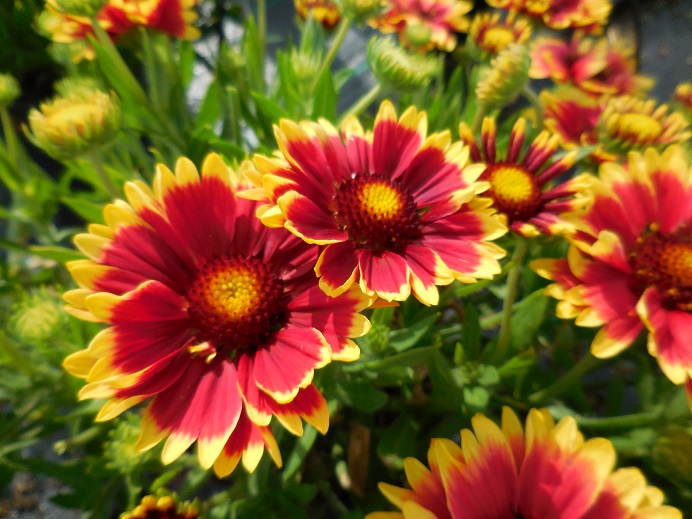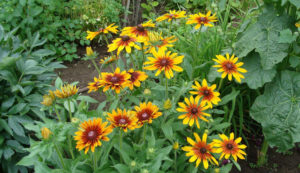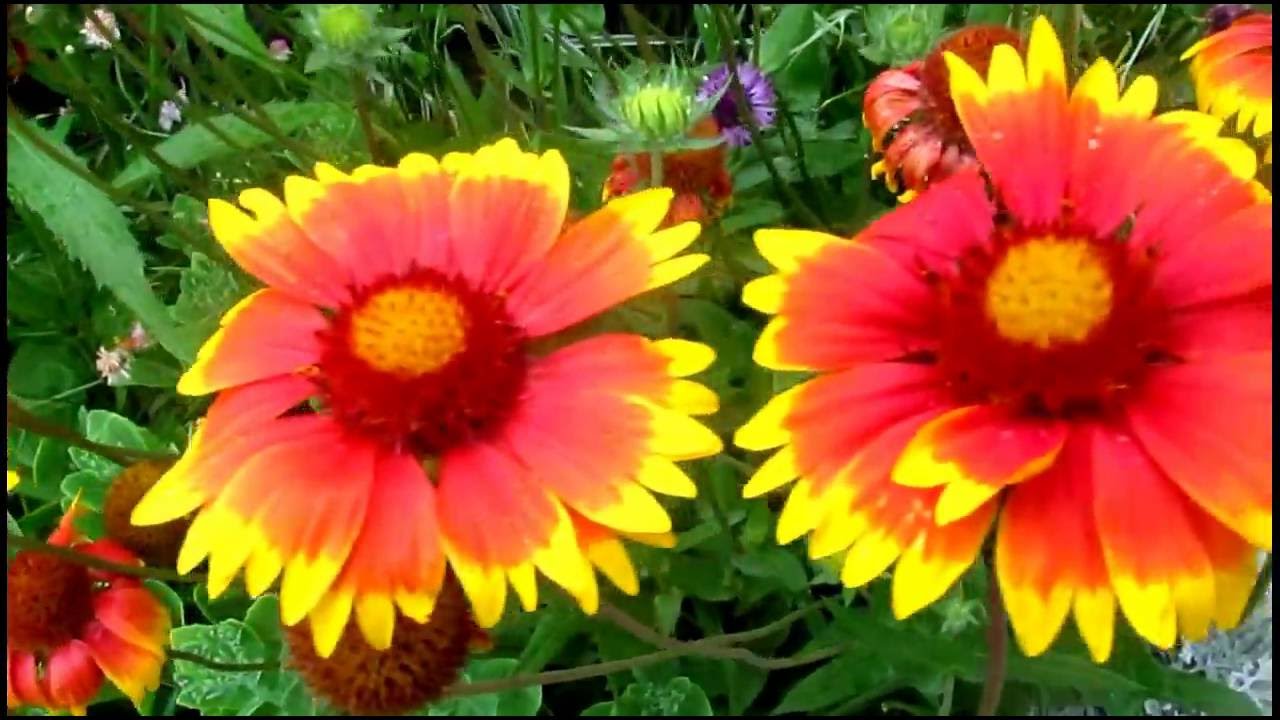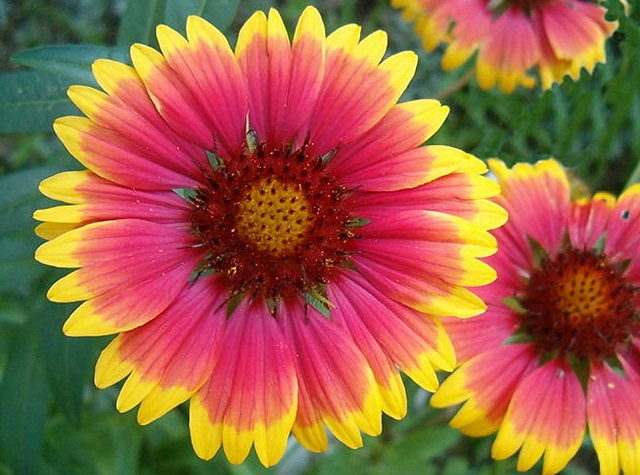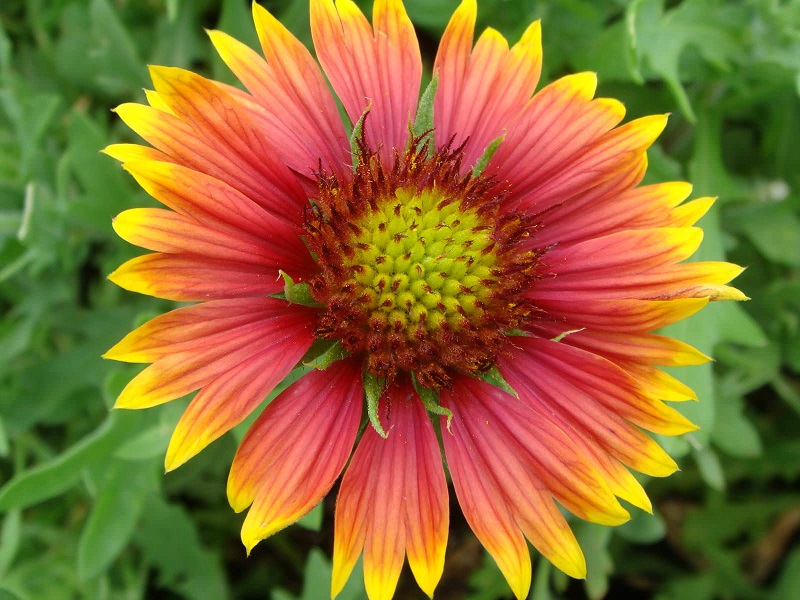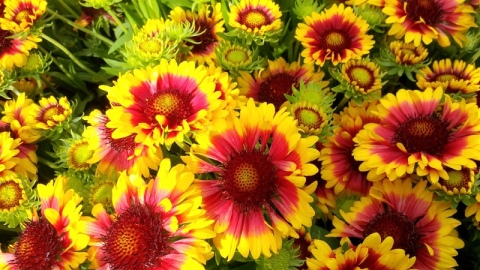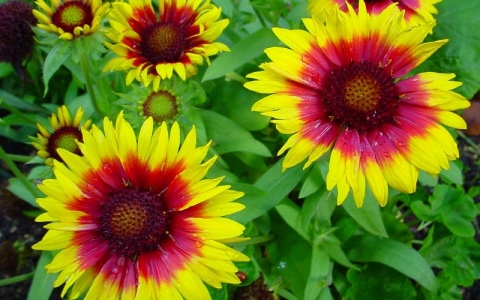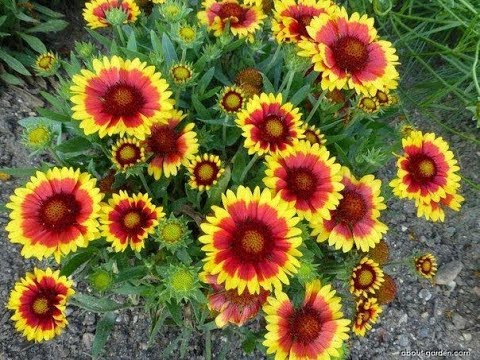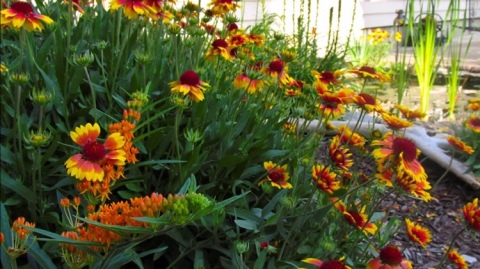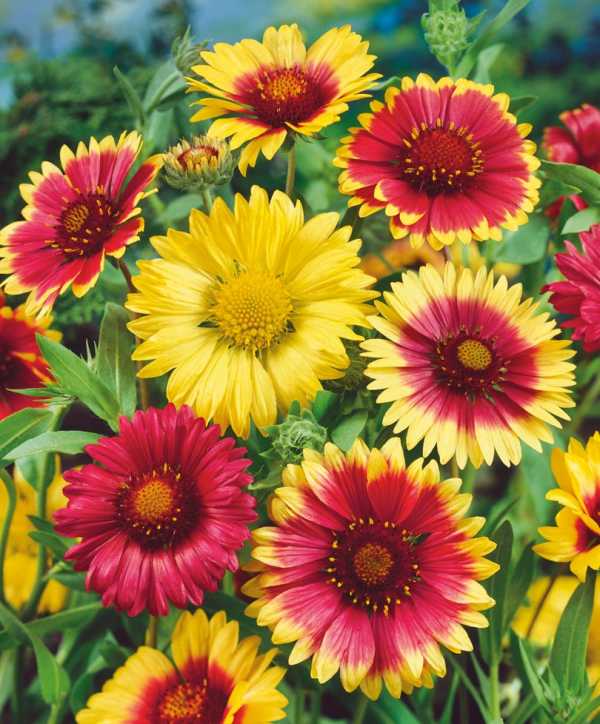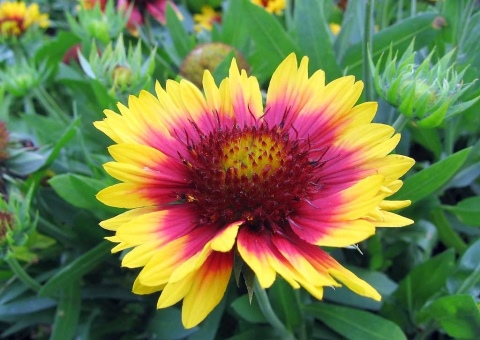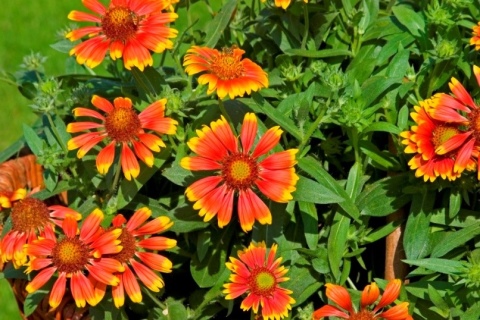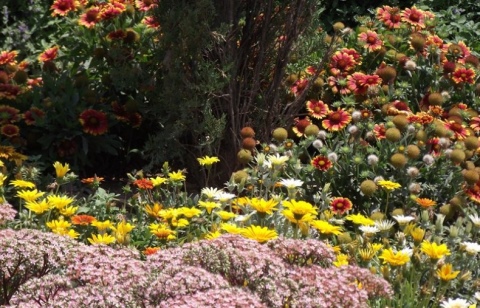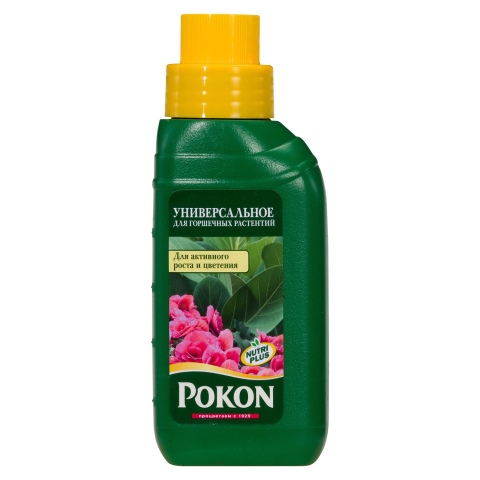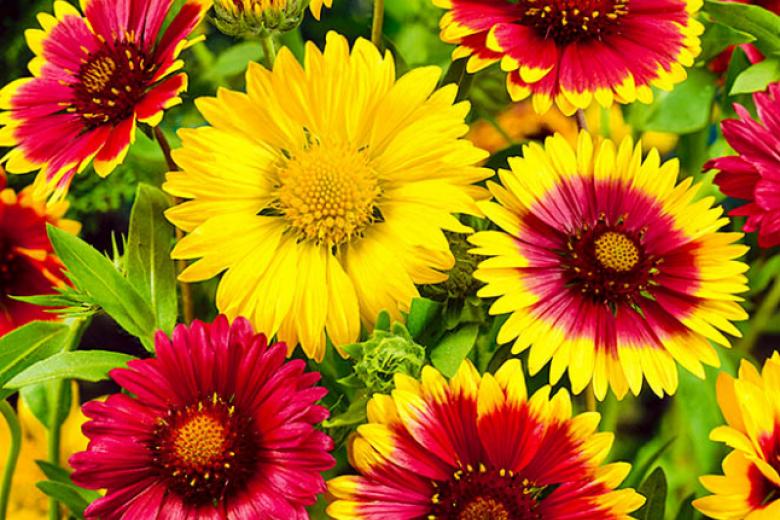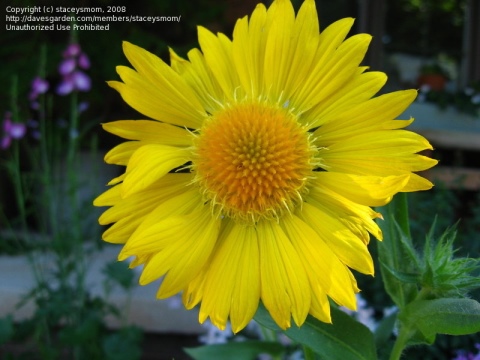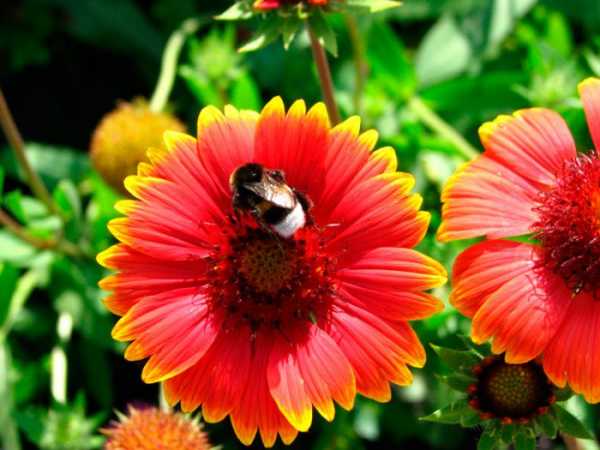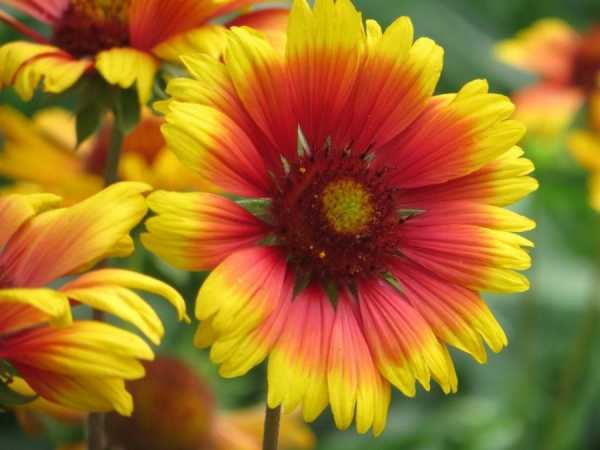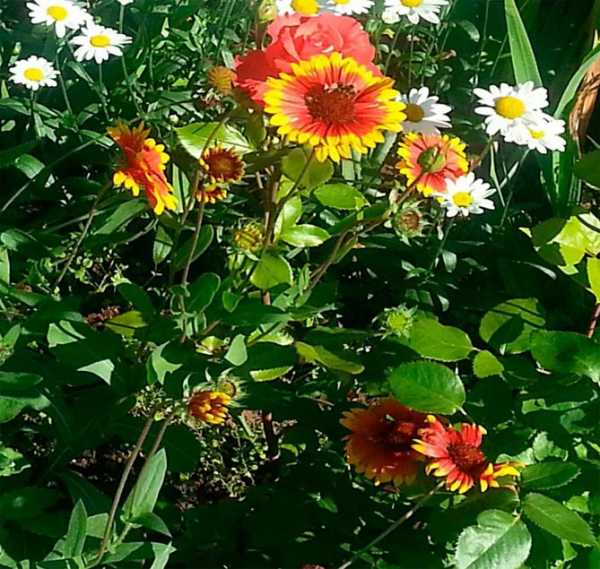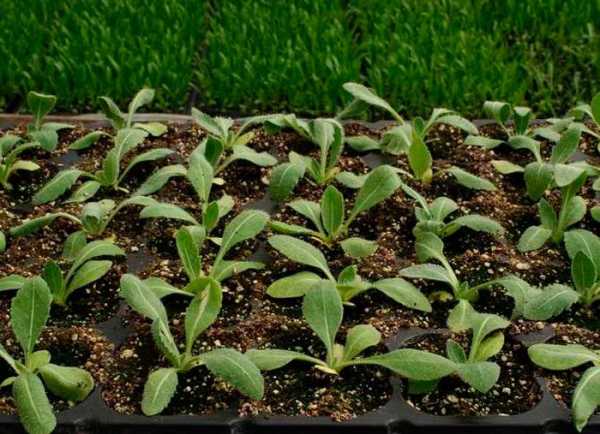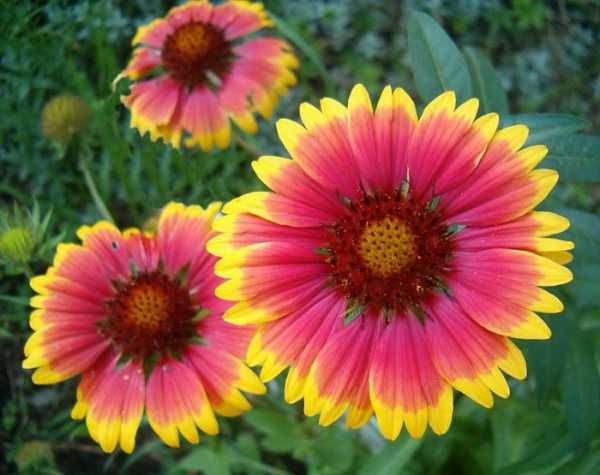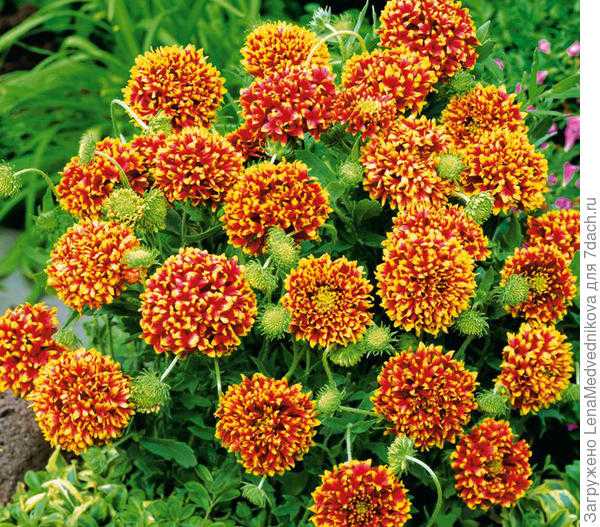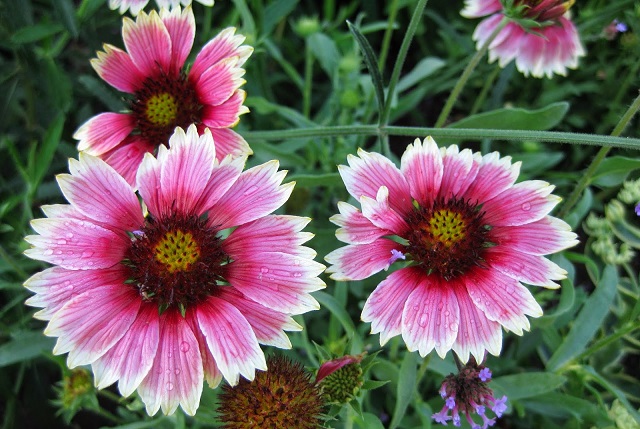Transfer
Thinning of the grown bushes is the best method for preserving the decorative plantings against the background of crowded plants. First, they prepare sufficiently deep pits, fill them with water, add a little mineral fertilizers (10 g per 1 liter of water)
An adult plant is divided into two or three parts: it is important to preserve the integrity of the roots and growth zones, carefully move to a new place
The same rule applies when transplanting young bushes grown from seeds. There should be up to 25 cm of free space between the plants. The transplanted flowers are quickly accepted. The soil is loosened, fertilized, watered, do not allow excessive dryness of the soil, but it is not worth pouring Gaillardia.
Peculiarities
The colorful Gaillardia is closely related to asters and is grown in annual and perennial varieties. Gaillardia beautiful refers to annual species, while perennials include all varieties of awned varieties and hybrids.
Gaillardia perennial looks like a spreading bush with light green leaves covered with a light downy. Depending on the variety, the leaves of the plant can be narrow, like a lancet, or resemble an elongated shoulder blade. On the same plant, the edges of the green leaves can be carved, but the closer to the buds, the narrower and smoother the shape of the leaf plate becomes. Another feature of the leaves: those that are located on the stems are sessile, and the lowest ones, forming a basal rosette, are petiolate.
During flowering, the spreading Gaillardia bush resembles a round basket, completely covered with large bright flowers. The height of the peduncle in the spinous variety ranges from 0.35 m to 0.75 m, hybrids can be of different sizes: from dwarfs and semi-dwarfs, about 0.25 m high, to rather tall bushes, the buds of which open at a height of about 0.9 meters over the ground.
The Gaillardia flower looks like a bright sun, consisting of a dense large core surrounded by a row of petals, often having a two-color color, reminiscent of tongues of flame. There are simple, semi-double and terry types:
- simple flowers have one or two rows of reed or funnel-shaped petals with a carved top;
- semi-double inflorescences already adorn more than two rows of petals around the core;
- double flowers resemble fireballs on high legs, formed from petals in the form of a high funnel.
The perennial is unpretentious in its habitat and is drought-resistant, which is very good for beginners in floriculture and those who do not have the opportunity to constantly monitor the state of the flower garden.
Growing Gaillardia from seeds
Sowing Gaillardia.
Annual Gaillardia is grown by seed seedlings. Sowing is carried out in February or March. Large seeds of Gaillardia are laid out on the surface of a wet substrate and only lightly sprinkled with vermiculite, although this may not be done. Keep crops in a bright place at a temperature of 20-23 ºC, covering from direct sunlight and moistening the soil as needed. Seedlings appear in about a week or two.
Seedlings of Gaillardia.
As soon as the Gaillardia shoots appear, transfer it to a cooler place - the seedlings should grow at a temperature of 18-20 ºC. A cold greenhouse is best suited for this purpose, since the air humidity at which the seedlings will successfully develop must be increased. As soon as the seedlings develop the first pair of true leaves, they are planted more freely.The soil must be moistened after the topsoil has dried. Daylight hours for seedlings should last 14-16 hours, so you will have to install fluorescent lamps, otherwise there may be a risk of seedlings becoming sick with gray rot from a lack of light and high humidity.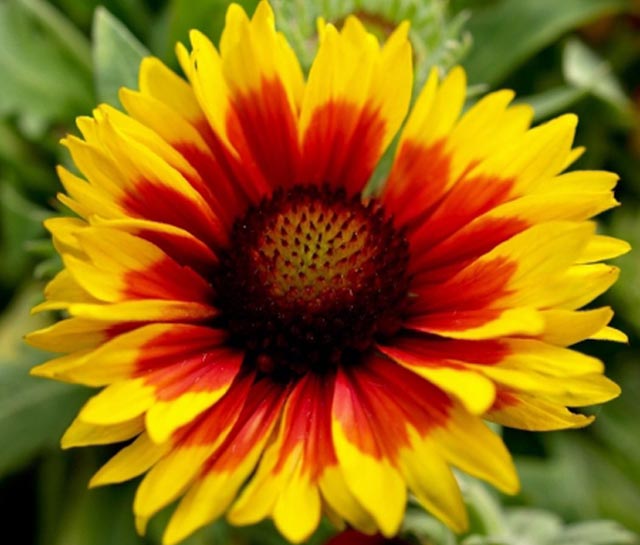
Reproduction
Flower propagation can be done in several ways:
- Seeds.
- By dividing the bush.
Planting seeds for seedlings is done in April. Seedlings can also be grown in the open field, planting them shallowly in a prepared place. The first shoots appear 14 days after planting. Seedlings need moderate regular watering. It should be borne in mind that the plant has a negative effect on excess moisture. The plant can be planted in a permanent place in August.
Planting seedlings can be carried out immediately on a permanent site, in which case the seedlings, after strengthening the root system, will need to be thinned out. Extracted shoots with intact roots can be planted in a new place.
Reproduction of Gaillardia by self-seeding
Seed propagation requires selectivity in the choice of planting material. It is necessary to leave the achene only on those bushes that, during the entire flowering period, were distinguished by bright saturated inflorescences. Growing Gaillardia from seeds of all specimens present in the garden leads to the appearance of degenerate inflorescences with a pale color.
It is advisable to reproduce a flower by dividing in early spring, so that it has time to take root before flowering. As a last resort, the division can be carried out in early September, when the Gaillardia has faded.
The simplest option is self-seeding flower reproduction. To do this, it is necessary to leave several baskets on the stem until the fall, from which seeds will spill out, which will sprout next spring. Growing flowers as a result of self-seeding requires their timely planting.
Gaillardia, leaving
Although Gaillardia is perennial and not whimsical to care for, there are basic points, the observance of which will allow you to effortlessly grow these flowers in a flower bed.
The soil
Perennial prefers light, fertilized soil. You cannot fertilize with manure, because this organic fertilizer negatively affects the development of the plant. Humus, compost, woody ash and complex mineral fertilizers - these are the main components that improve the growth of the shrub. Loosening, mulching the soil and removing weeds contributes to the enrichment of the soil with oxygen and, accordingly, the optimal growth of the plant.
Watering
Excess moisture is detrimental to the plant. A drought-resistant bush prefers moderate watering (as the soil dries up) and does not tolerate waterlogging and stagnant moisture. It is waterlogging that can provoke various plant diseases. Timely watering is especially important when transplanting a young plant for its further rooting. An adult plant perfectly tolerates dry weather and a prolonged lack of moisture.
Transfer
After 4-5 years, the plant needs replanting. As a rule, during this period (in spring) the bush is planted by propagating it in a vegetative way, that is, by dividing it into several parts. All daughter plants should have full shoots and rhizomes, after which they are planted in a new place. While the plant takes root, you need to provide it with careful care. Moderate watering, loosening the soil, pruning the stems at the root after the end of flowering (in the first year) - these measures will be able to extend the existence of the perennial for several years in the future.
Tying
So that the perennial shrub does not break down and does not disintegrate too much, especially in windy weather, it is necessary to ensure its tying. Separate sticks (props) or stable stems of neighboring plants (for example, irises) are used as support. You can also completely tie the bush with twine, thus preserving its decorative appearance.Tying should be carried out in advance, avoiding strong overgrowth of the bush. This process is especially relevant for tall varieties of Gaillardia.
Preparing for winter
Perennial Gaillardia is a fairly frost-resistant plant, but in anticipation of a harsh winter, it is better to take some protective measures. It is recommended to cover shrubs with fallen leaves, peat or spruce trees. If the temperature is not too low in winter, there is no need to cover the plant with anything.
Fertilizer and feeding
To ensure optimal growth and flowering, perennials need to be fed regularly. It is best to apply mineral complex fertilizers, humus and compost during periods of maximum plant load. There are 3 such periods: in spring, when the plant actively throws out and sets buds of future flowers; in summer, during active flowering and in late autumn, after cutting off all the peduncles.
Reproduction methods
In order to propagate the plant he likes, the owner can use two methods: sowing by seeds and vegetative.
Seeds
For propagation by seeds, you can use purchased material or collected from the mother plant yourself
But here it is important to remember that hybrid varieties when grown from seed can lose their distinctive properties, returning the characteristics of the mother plants. Therefore, for the propagation of hybrid varieties, it is worth using seed from trusted manufacturers or propagating hybrids only by dividing the bush. Sowing seeds for seedlings can be done directly in the ground or in early spring indoors
Sowing seeds for seedlings can be done directly in the ground or indoors in early spring.
In open ground, perennial seeds are sown in mid-July. Seeds are scattered over the surface of the prepared soil, slapping slightly. You can sprinkle them with a thin layer of soil, or you can leave them open. As a maintenance, regular moistening of the soil surface is required. The seeds sown in this way will have time to sprout and build up a good root system, which will allow the seedlings to survive the winter and please with flowering with the onset of summer.
The same sowing method is used in spring. Only grown and strengthened seedlings can be transplanted to a permanent place by autumn.
Podzimny sowing requires the obligatory cover of lightly dusted seeds. In the spring, after the emergence of seedlings and the onset of stable heat, the covering material is removed. Follow-up care consists of watering and weeding. By autumn, the grown outlets are transplanted to the place where they will grow for the next 4-5 years.
Sowing seeds in a heated room is carried out in late February - early March. Drainage is placed in the seed boxes, a light substrate from compost, garden soil, sand with the addition of wood ash is poured on top. Seeds are spread over the soil surface without deepening. The surface is sprayed with water and covered with foil or glass. The seed boxes are placed in a bright, cool place out of direct sunlight. The ambient temperature should be no higher than 20 ° -22 ° C.
With the appearance of the first real leaves seedlings they are seated in separate peat pots, which is very convenient for planting grown seedlings in the ground, since Gaillardia is difficult to transplant at such a young age. The seedlings are kept at a temperature of 18 ° -20 ° C.
With the onset of warm days and the end of the threat of frost, the mature seedlings are planted in a permanent place.
Vegetative way
The most reliable method of reproduction while maintaining the varietal characteristics of perennial Gaillardia is vegetative.
After the plant reaches the age of 4-5 years, the bush needs rejuvenation and transplantation. This is the best time for breeding.
The division of the bush is carried out in the spring, before the onset of the flowering period. The bush taken from the ground along with the roots is divided into several parts so that each delenka has a sufficient number of roots and shoots.
After that, the divisions are planted in the selected places, using the same method as when planting the mother plant.
Those who like to experiment can try to propagate the variety using pieces of large root at least 5 cm long. The healthy root cut into pieces is buried in the ground and covered, creating a greenhouse effect. If successful, green shoots will appear after a while.
Cuttings
Some people try to propagate Gaillardia by cuttings. The success of this operation is unlikely, since the probability of engraftment is no more than 50%. Therefore, this method may be suitable for those who like to experiment in the garden.
Annual Gaillardia diseases and pests
Gaillardia is often sick. The development of diseases and the appearance of pests is facilitated by improper care - planting in the shade, abundant and untimely watering. Plants have the worst case in rainy and cold summers.

Whitefly
Most often, Gaillardia has to be treated for the following diseases:
- Gray rot. The lower leaves darken, curl up and dry out. If you leave this unpleasant symptom of the disease unattended, then the upper part of the bush and buds will similarly await. Ultimately, Gaillardia will die. To combat gray mold, insecticides are used. Damaged plant parts are regularly removed.
- White rust. The main symptom of the disease is white bloom on the leaves. It may appear on both sides at first as a small spot, but gradually spread to the entire leaf, changing its color to brown. At first it looks like mold, but as the disease spreads, the mold takes on the appearance of cotton wool.
- Powdery mildew. The leaves are covered with a white, flour-like bloom. The reason for the development of the disease is frequent watering and the presence of a large number of weeds on the site.
They fight diseases by spraying flowers with such fungicides as: "Topaz". "Stroby", "Maxim". Experienced gardeners also recommend using various biological agents, such as "Abiga-Peak", "Alirin B".
Aphid
Weakened plants are often attacked by aphids and whiteflies. A solution of nettle helps to cope with aphids, they are sprayed with infected plants about 1-2 times a week. "Tanrek" or "Fitoferm" help to get rid of whiteflies.
Gaillardia is a beautiful flowering plant that can often be found in private households and on roadsides. It grows quickly, reproduces well, including seeds, pleases with a long and abundant flowering from July to the end of September. If Gaillardia is properly cared for, then it almost does not get sick, and fungicides will reliably protect it from aphids and other pests. Blooming Gaillardia is a decoration of any garden.
Features of the flower and the most popular varieties (with photo)
In the photo, Gaillardia flowers look mesmerizing. There are two-color, one-color, rarely - tricolor Gaillardia. It all depends on the variety and the efforts of the breeders. the most popular varieties of Gaillardia are presented on the page below, their features are considered.
Consider these types of flowers:
Gaillardia spinous - refers to perennial plants. Composite. Since the height can reach 75cm and more, a garter is needed to make the bush look richer. The diameter of the inflorescence is 12 cm. It is dominated by yellow, orange and copper colors. In one place, the plant feels great for about 4 years, after which it requires a transplant. Loves the sun, is unpretentious to water, does not need additional fertilizers;
Gaillardia Arizona - differs from others in a compact, but dense bush, reaching a height of 40 cm. It blooms from early spring to late autumn. It does not require a lot of water, but it must be planted in places that will not obstruct the sun's rays. Does not need fertilizing. The inflorescences are bright red in color, up to 10 cm in diameter. It fades very quickly, blooms longer than all other varieties;
Gaillardia hybrid is a profusely lurking bush, up to 80 cm high.Tricolor inflorescences, up to 10 cm in diameter, are painted in yellow, orange and brown tones. There are both semi-double and double forms. They begin to bloom from June until frost. You can safely plant in one place for up to 5 years. They prefer dry soil, water and sunlight;
Gaillardia burgundy is a wine-colored flower, reaching a height of 60-70 cm. The diameter of an inflorescence in the form of a basket is up to 12 cm. They prefer dry soil. Best planted in an area with good access to sunlight. In one place it can grow up to 4 years;
Gaillardia Lorenziana is a spreading flower, 50 to 60 cm in height, which is lowered with soft hairs. Single inflorescences, which are spherical, 6-7 cm in diameter. Blooms from late June to late October. Seedlings should be planted in areas with sufficient access to sunlight. Will bloom well in dry soil. Ideal for equipping flower beds or curbs.
There is nothing difficult in caring for such plants. Among the general requirements for care, you can highlight:
- the homeland of the plant is North and South America;
- open area, with good access to solar heat and rays;
- the soil should be loose, with free access to water;
- inflorescences are wide, there are often two-color, less often one- and three-color;
- large bushes must be tied up;
- after the plant has been in one place from 4 to 5 years, it should be transplanted;
- frequent feeding is not necessary, it is enough to fertilize with minerals three times, as described above.
Such plants are very well suited for urban conditions - they look great in parks, squares and courtyards of residential complexes.
The main thing is that they can be planted in combination with other plants. Thus, the bush will look elegant. It will coexist with any plants without problems, you can not worry about it.
How to grow Gaillardia from seeds
There are 2 methods of growing Gaillardia from seeds: the first is by direct sowing into the ground, the second is by seedlings.
If we sow on seedlings at home

Gaillardia growing from seeds when to plant Seedling photos
- When to plant Gaillardia seeds? Sowing begins in early March.
- They take a wet substrate and distribute rather large Gaillardia seeds on its surface.
- From above, you can sprinkle with nutritious soil or vermiculite - an active mineral component that contains a complex of elements for plant growth, and this is iron, silicon, potassium-magnesium compounds, etc.
- The place where crops are kept should be bright, but not accessible to direct sunlight.
- The optimum temperature should be between 20 and 22 ° C. Seed germination time is from one week to two.
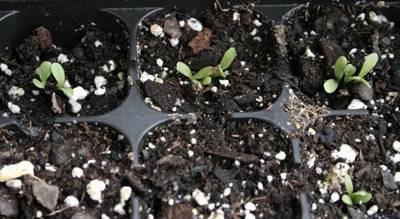
Gaillardia from seeds Shoots of Gaillardia photo
With the emergence of seedlings, it is necessary to start moving the seedlings to a place where the temperature will not exceed 18-20 ° C. A cold greenhouse is a good choice, which will not only provide the right temperature, but also create the high humidity that is so necessary for the growth of plants. Watering is carried out as the soil surface dries up. To avoid the risk of infection of the seedlings with diseases such as gray rot, which occurs due to very high humidity, do not flood the plants. If the light in the house is poor, it is necessary to equip the room with fluorescent lamps in order to increase the length of daylight hours to 15 hours. Saplings grow well and form new leaves
For them to develop fully, it is important to provide enough space: in a box or container, leave a distance of at least 5 cm between the plants and transplant the remaining seedlings into separate cups. The picking of seedlings into looser containers is carried out when the first pair of true leaves develops well
After diving, when a couple of weeks have passed and the seedlings are actively developing, do not forget to harden
Leave the plants on the street or open balcony for an hour or two a day, gradually increasing the time "in the sun" until a full day. when the seedlings spend the night perfectly on the street, they are boldly planted in the ground.
Do not forget about the danger of frost. Only when the temperature is above zero at night, you can leave the plants outside.
If we sow in open ground
It's just that Gaillardia seeds can be sown into the ground as soon as the weather is good and the soil is ripe. Gaillardia can multiply by self-seeding, and therefore the seeds are not afraid of low temperatures. Seedlings will appear only with the onset of favorable conditions.
We make shallow grooves at a distance of 20 cm from each other
Carefully place the seeds in the furrows. They are a little inconvenient to sow due to the sharp tips that resemble umbrellas.
But try as little as possible. Sprinkle with earth using a rake. Water abundantly, but so that an earthen crust does not form after drying (in appearance, the earth should remain loose). After a couple of weeks, you will need to break through the seedlings and remove the weeds. The garden bed can be used as a future flower bed and a breeding ground for transplanting excess plants to another place. As a result, we leave in the row the distance between the bushes of 20-25 cm.
Perennial Gaillardia is growing rapidly, but will bloom only next year. Be patient!


